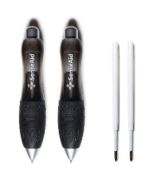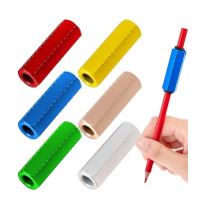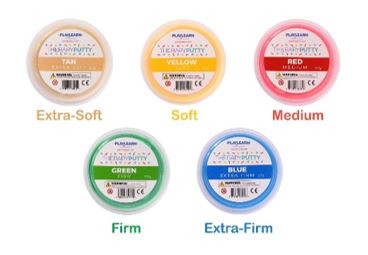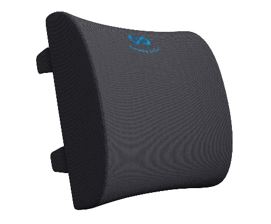Writing Big: Parkinson’s Disease & Handwriting
For today’s topic, we enlisted the expertise of Andie Hill, an Occupational Therapy student at the University of Mary in Bismarck, North Dakota. Recently, she has worked with APDA’s Northwest Chapter, helping people with PD manage various symptoms of PD and improve their quality of life, including issues with handwriting.

Writing is a basic life skill that we take for granted – until it becomes difficult. When writing becomes challenging, it can have a big impact on an individual’s quality of life. Simple tasks such as signing your name on a form, making a grocery list, or leaving a quick note for a family member can become onerous. And like many activities that require precise fine motor skills, writing can be affected by PD. But there are strategies that you can use to improve your writing and make this activity less cumbersome for you.
How does Parkinson’s disease affect handwriting?
- People with PD tend to make reduced, slow movements, which can impact many activities of daily living including handwriting. The handwriting of someone with PD is often small and cramped, also known as micrographia.
- A person with PD may also have trouble with motor planning which impedes the ability to follow the correct steps to produce a desired movement. This too can make writing more difficult.
- Tremor, dystonia, and dyskinesia, common unwanted movements of PD, can interfere with writing and typing.
Ways People with Parkinson’s Can Improve Handwriting
So, how do people with PD improve their handwriting? There are multiple strategies including the use of adaptive equipment, practicing specific exercises, utilizing hand strengthening techniques, and employing proper body positioning while writing – all of which we will explain below. Seeking the help of an Occupational Therapist (OT) can be beneficial as they can observe your specific situation and work together with you to find the solution(s) that best suits your needs. It’s possible that if you’re having issues with your handwriting, you might be experiencing other symptoms that an OT can help with as well.
Adaptive Equipment
If you are experiencing tremors, dystonia, or dyskinesia, a weighted writing implement or a writing utensil with a built-up grip can help decrease the amplitude of these movements (see below for some examples). Wearing weights on your wrists may help as well.
In addition, there are a number of writing utensils designed to help those who have difficulty writing. PenAgain, for example, has a unique shape that decreases the need to grip tightly on the pen or pencil, making it easier to write for some people with PD.
Another adaptation that can improve handwriting skills is a slant board. Slant boards create the optimal writing angle of 20-30 degrees, which assists in forearm stabilization and allows for a slight bend of the wrist to provide a functional writing position. Before purchasing a slant board, try leaning on a 3-ring binder to see if writing on a slant works for you.





Writing Exercises
A recent study showed improvements in fine motor skills and handwriting speed for people with PD after completing a handwriting exercise program. The handwriting exercises in this program consisted of writing the alphabet five times per day for four weeks using ½-inch graph paper.
Here are some Occupational Therapy tips you can try at home to work on your handwriting:
- Practice lower-case letters and upper-case letters
- Practice with different adaptive writing utensils and wrist weights
- Practice writing in different sizes
- Write one letter BIG using the whole page of a notebook
- Write one letter per 3×5 index card or sticky note
- Use ½-inch graph paper (or bigger) and write one letter in each box
- Practice writing ABCs on a whiteboard – BIG!
- Practice writing ABCs with your eyes closed since decreasing visual input may improve micrographia
- Utilize external cues
- Write along to the beat of music to keep a steady pace
- Speak out loud as you write
Strengthening Exercises
Strengthening the hands can help maintain independence with activities of daily living in PD. Working the small muscles of the hands and fingers can help improve fine motor control and hand dexterity, which can translate into improvements in writing.
Here are some Occupational Therapy tips to exercise the muscles of the hands. Perform 10-12 repetitions of these exercises 1-3 times per day to see results:
- In-Hand Manipulation:
- Hold an object in the palm of your hand, move it to your fingertips and back to your palm, and repeat
- Hold a round object in your hand and rotate it clockwise and counterclockwise
- Finger Isolation:
- Place your palm and fingers flat on a table, lift one finger up at a time, and repeat with all fingers
- Make an “O” by touching your thumb to each of your fingers
- Pick up coins from the table using your thumb and one finger to pinch, and repeat using each finger
- Strengthening:
- In the palm of your hand, squeeze an object that has resistance
- Theraputty
- Start with one strength and build your way up as you get stronger
- Theraputty
- In the palm of your hand, squeeze an object that has resistance

- Stress ball or rolled-up socks can work as well
- Place a small rubber band around two fingers at a time and stretch the band
- Finger Exerciser
- Start with one strength and build your way up as you get stronger

Proper Body Positioning
Proper body positioning and seating ergonomics can help improve writing. When sitting at a table to either work on the computer or write, keep in mind the 90-90-90 rule. Your elbows should be bent at 90 degrees and at the same height as the working surface, hips should be at a 90-degree angle with your bottom against the back of the chair, knees should be at a 90-degree angle with space between the chair and the back of your knees, and your feet should be flat on the floor. This picture represents proper seating ergonomics while working on a computer

Tips From an Occupational Therapist:
- Make sure your chair is comfortable and has proper low back support
- Use a lumbar support pillow
- Supports upper, middle, and lower back depending on placement
- Improves posture
- Use a lumbar support pillow

- Take frequent movement breaks (every 20-30 minutes)
- OTs like to say, “Proximal stability for distal mobility”
- Make sure your back and trunk are well supported so your arms and hands can complete tasks
Tips and Takeaways
- Handwriting issues are common in people with PD, but there are a variety of tips and adjustments that can help you improve
- Weighted instruments, instruments with built-up grips, and specially designed instruments can help handwriting for people with PD
- Writing exercises have been shown in a small clinical trial to improve the writing of people with PD
- Hand strengthening techniques can be helpful to improve writing
- Proper body positioning is essential to support writing
- If handwriting continues to be a challenge despite trying these various methods to improve it, you may consider seeking the advice of an Occupational Therapist who can assess your personal situation and make recommendations that are specific to you
References
- Beck, C. (2016). Handwriting. The OT Toolbox. https://www.theottoolbox.com/why-use-slant-board/
- Kanno, S., Shinohara, M., Kanno, K., Gomi, Y., Uchiyama, M., Nishio, Y., Baba, T., Hosokai, Y., Takeda, A., Fukuda, H., Mori, E., Suzuki, K. Neural substrates underlying progressive micrographia in Parkinson’s disease. Brain and Behavior, 2020. 10(8).
- Mo, J., Priefer, R. Medical devices for tremor suppression: Current status and future directions. Biosensors, 2021. 11(4): 99
- Nackaerts, E., Broeder, S., Pereira, M., Swinnen, S., Vandenberghe, W., Nieuwboer, A., Heremans, E. Handwriting training in Parkinson’s disease: A trade-off between size, speed and fluency. PLoS ONE. 2017. 12(12).
- Wang, T., Xiao, G., Li, Z., Jie, K., Shen, M., Jiang, Y., Wang, Z., Shi, X., Zhuang, J. Wuqinxi exercise improves hand dexterity in patients with Parkinson’s disease. Evidence-Based Complementary and Alternative Medicine, 2020.
- Vorazoot, N., Termsarasab, P., Thadanipon, K., Pulkes, T. Effects of handwriting exercise on functional outcome in Parkinson disease: A randomized controlled trial. Journal of Clinical Neuroscience, 72(2020), 298-303.
